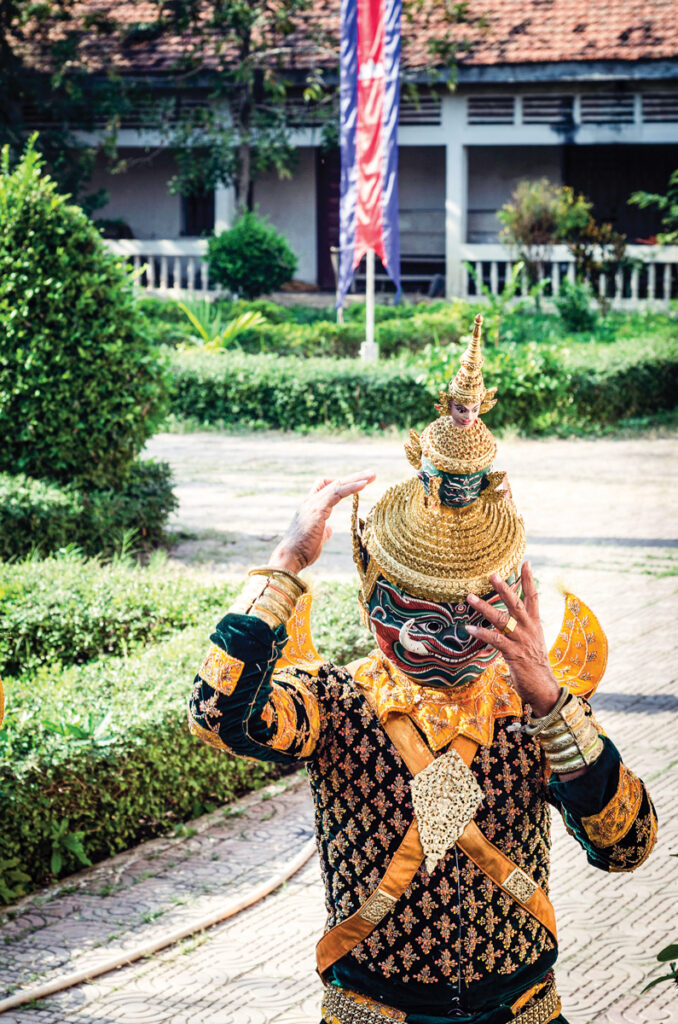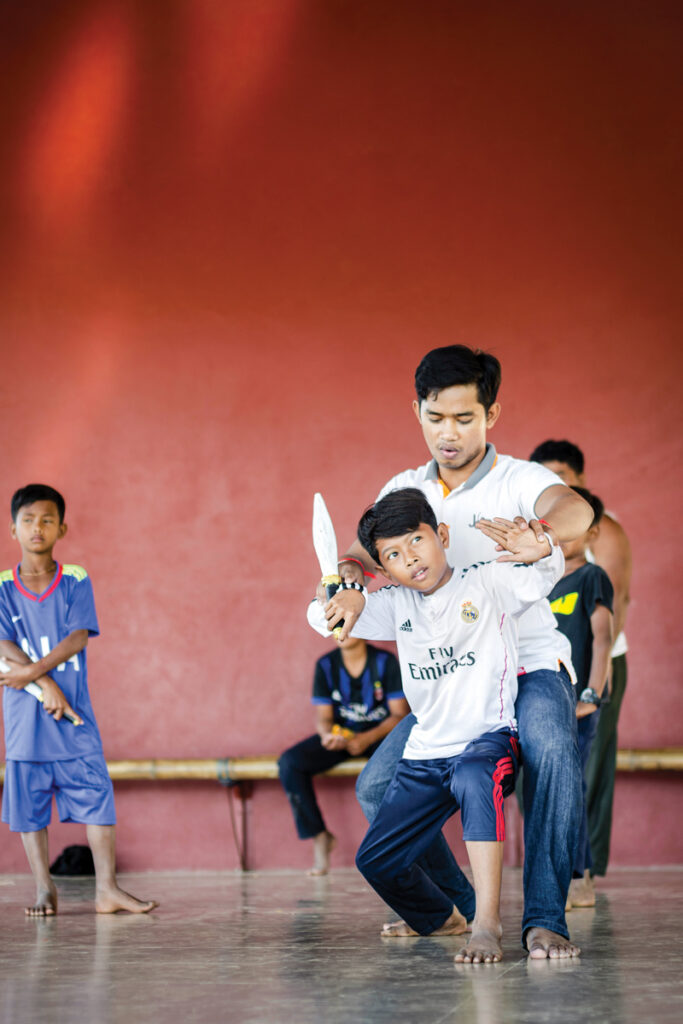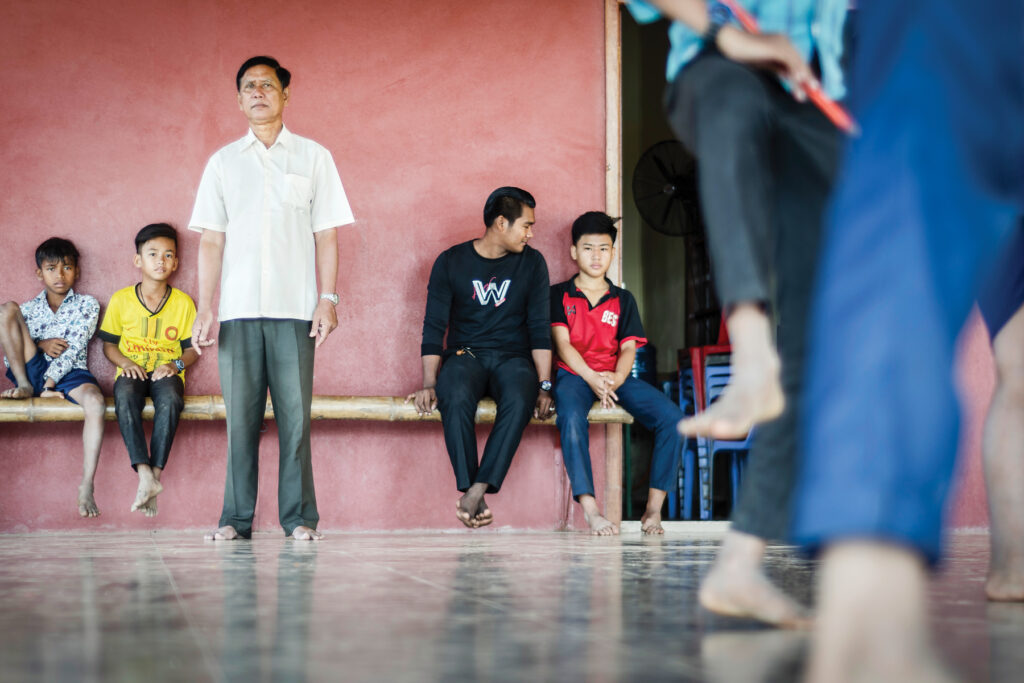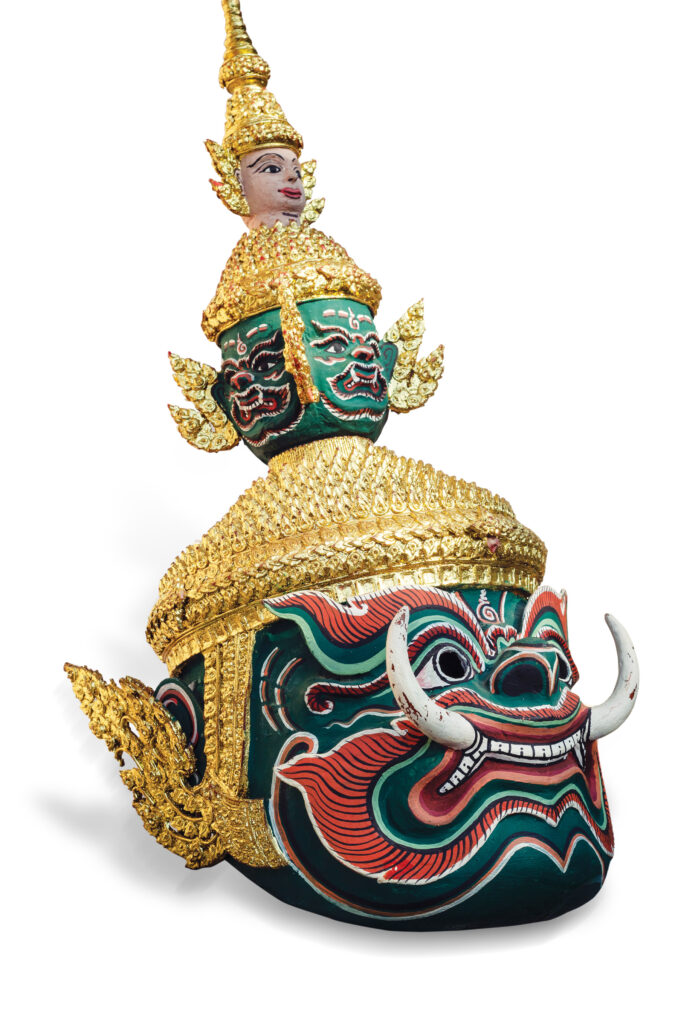Recently granted heritage status by Unesco, the ancient Khmer masked dance known as Lakhon Khol is bringing together a riverside community after a post-Khmer Rouge revival

Words by Samantha McCabe, Photography by Jack Malipan
Costumes dipped in bright jewel tones and sparkling gold. Fantastical masks with peaks that reach for new heights, adorned with multiple painted, grimacing faces. Stomping feet, swirling arms, prancing legs. An evil demon whisking away a beautiful young woman, leaving her husband to search for her far and wide.
The scene isn’t real, not entirely – it’s a reenactment of Lakhon Khol, an all-male traditional masked dance that’s been intertwined with Cambodia’s history for centuries.
Lakhon Kohl is based off the national variation of the ancient Indian epic poem Ramayana, – known as the Reamker in Khmer – a tale of love, loyalty, revenge and trust. For years the last vestiges of the performance seemed to be swirling around the drain, strangled by the Khmer Rouge and their bloody mission to eradicate what they considered decadent forms of art. But one group is keeping it alive.
An abridged version of the Reamker story goes: when the beautiful Sita is kidnapped by a ten-headed giant, her husband, King Rama, enlists the help of monkey general Hanuman and his army to find his wife. They eventually locate her and kill the seemingly invincible demon king, Ravana, but the trust of their relationship is eroded forever, even though she never betrayed him.
Lakhon Khol Wat Svay Andet is one iteration of this masked dance, practised in a riverside community in Kandal province about an hour’s tuk tuk trip east of Phnom Penh. On a steamy Sunday morning in mid-December, boys as young as five dart across the wide tiles of the practice facility within the pagoda from which this variation takes its name, light on their feet as they chat and wrestle with one another between breaks. Their feet kick up dust as they practise their moves in small groups on the main plaza space under the watchful eye of their teachers. They are training for their performances, usually held only once a year just after Khmer New Year in April.


Sok Kimsan, a 22-year-old who now counts himself as a “first generation” alumni as one of the older practising members, plays Hanuman and one of the smaller monkey warrior roles.
“I remember when I saw my father perform for the first time when I was a kid, and I thought, I want to learn about that,” said Sok, who works as a tailor. His great-grandfather also played Hanuman, and calls the character part of the “family heritage”. If he has male children in the future, he plans to pass the dance on to them, too.
Sok, like many of the young men sweating out their energy at the wat, started learning Lakhon Kohl because of its familial significance – it’s very common that the boys will take on the same character that their paternal figures did.
But as far back as Sok’s family history with the dance seems to stretch, Lakhon Khol goes back even further: it began in the early Angkorian period, believed to have first been performed in the ninth century judging by bas-reliefs on the walls of Angkor Wat.
In the present day, the group practises for their performances every Sunday, but these weekend meets represent so much more. They glue the town together through a dance that is solely transmitted orally and dedicated to a deity that is said to look over the village and its people – though only if performed well.
Those who don’t have a father or grandfather who once practised the dance were pulled into the world of Lakhon Kohl after Poch Phai convinced them to join. Poch used to be the principal of the primary school – a squat, tan building that can be spotted from the pillars of Wat Svay Andet – but has now moved to teaching Lakhon Khol full-time.
It’s a far cry from where he used to be, growing up near the old performance stage and watching from the wings as a young boy. His family was too poor to send him to participate, but in 1996 he managed to join the Lakhon Khol Wat Svay Andet committee and has been hooked ever since.
Many of the young men approach the dance with the same level of dedication. “Unlike other forms of dance, the performers here are not professional or full-time artists,” said Poch. “They are also not doing it for profit.”
A traditional orchestra and recitation form a gorgeous melodic backdrop to the performances. University freshman Phally Chamroeun first started on the drums as part of the musical band when he was just 12 years old before his teachers saw his budding potential and started training him in the dance as well. He plays the character of the giant, Ravana.
“I got involved because of the artistic connection that runs in the family,” said Phally, whose grandfather also taught the dance and played Ravana. “But I also worry that the art is being endangered now, and it might completely vanish one day.”
Many of the students feel the same, and even if they are too young to remember the history that Lakhon Kohl has staggered through, they recognise the role it serves in the community infrastructure and in the eyes of their parents and grandparents.

Poch is glad that the importance of Lakhon Kohl to the wider cultural quilt of Cambodia is slowly becoming more recognised. During a period of intense war and the blisteringly violent Khmer Rouge regime in the 1970s, the dance almost petered out entirely and teachers were unable to transmit their knowledge. The wat was turned into a Khmer Rouge prison and execution site.
After that time, the Wat Svay Andet group was the only troupe left in Cambodia and only through the effort of dedicated men, young and old, was it kept it alive. Everyone participates in addition to other jobs and family obligations, without pay or serious recognition.
In recent years, support from Unesco as well as the government have helped bolster their efforts and move from the old facility, which was beginning to collapse into the river, to the wat. In late 2018, the dance was inscribed on Unesco’s List of Intangible Cultural Heritage in Need of Urgent Safeguarding.
“Before, we did not have enough equipment,” explained Poch. “We used to borrow the costumes and masks from the Ministry [of Culture and Fine Arts]. But now we have our own set.”
“The training was not easy,” added Sok. “We didn’t used to have a proper training facility. I used to roll around in the sand when I learnt the dance.”
The protection from Unesco, however theoretical, meant a great deal to the elders of the dance.
“It’s a special connection to the locals here when they learn, perform, and then teach the younger members in their family,” said Poch. “It’s the family inheritance.”

Additional reporting by Thim Rachna
This story was originally published on Discover magazine 2020/21 vol.



